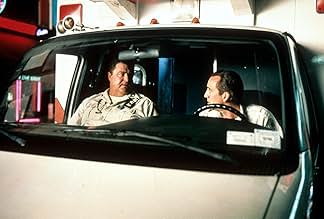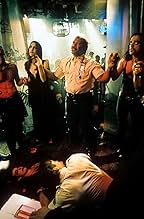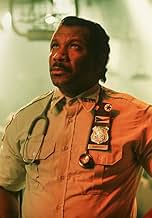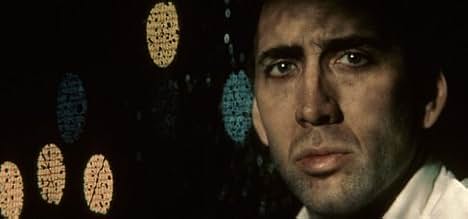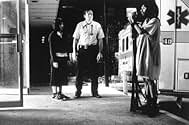Perseguitato dai pazienti che non riuscì a salvare, un paramedico di ambulanza di Manhattan estremamente esaurito combatte per mantenere la sua sanità mentale in tre notti turbolenti.Perseguitato dai pazienti che non riuscì a salvare, un paramedico di ambulanza di Manhattan estremamente esaurito combatte per mantenere la sua sanità mentale in tre notti turbolenti.Perseguitato dai pazienti che non riuscì a salvare, un paramedico di ambulanza di Manhattan estremamente esaurito combatte per mantenere la sua sanità mentale in tre notti turbolenti.
- Regia
- Sceneggiatura
- Star
- Premi
- 2 vittorie e 5 candidature totali
- Mr. Burke
- (as Cullen Oliver Johnson)
- Captain Barney
- (as Arthur Nascarella)
Recensioni in evidenza
Frank tells us at the movie's outset that he hasn't saved a life in months, and that he's beginning to believe in things like spirits that leave a body and don't want to come back. He's starting to feel like a "grief mop", like his only real responsibility is to "bear witness" to death and suffering. Frank and his partner Larry (John Goodman) are attempting to resuscitate a heart attack victim as the movie begins, and as the man's daughter Mary (Patricia Arquette) looks on in horror, Larry is successful in pulling him back from death's door. The overrun hospital, however, shoves him into a corner and keeps him drugged up, shocking him back to "life" when necessary. Mary tells Frank she hadn't spoken to her father for a long while before his attack, and in fact had often wished he were dead, but that now there's nothing she'd like more that to just hear his voice again. She was once a junkie but has now been clean for months, she tells him. Frank seems moved by Mary, seems to want to "save" her -- perhaps he thinks if he can save her, he will be able to let go of the pain of losing Rose.
Frank's developing feelings for Mary provide a counterpoint to the insanity he encounters on emergency calls with his partners Larry (John Goodman), Marcus (Ving Rhames), and Walls (Tom Sizemore). Sometimes the calls involve merely picking up the local smelly drunk Mr. O, their "most frequent flier" who seems to think the hospital is a nice place to sober up. Other times they involve matters that are much more serious, like resuscitating a heroin OD in a club (a great scene) or assisting in the allegedly virgin birth of twins (haunting, and one of the movie's many examples of religious imagery). But no matter where Frank goes, he sees Roses' face -- he sees her everywhere, she comes to him in the guise of the nameless street people that cross his path.
There really is no plot to "Bringing Out The Dead", and that's a good thing because the movie isn't meant to be a straightforward narrative. It's meant to be a snapshot of a man's soul, of his inner demons, and a conventional plot would only cloud the movie's real point. The narrative thrust comes mostly from Frank's interactions with his partners -- each of them representing a different approach, a different way of dealing with the pain brought on by this nerve wracking job. Larry (Goodman) seems to be able to block out the emotional aspects of his job, he seems to see his position mainly as a means to an end, and in fact he tells Frank he'll be a captain one day. Marcus (Ving Rhames, in a scene stealing performance) puts all trust and faith in God, believing that if someone dies, it's just their time to go. Walls (a scarily effective Tom Sizemore) is a borderline psychotic, terrorizing patients (including dread locked street person Noel, well played by singer Mark Anthony) and bashing in his ambulance headlights with a baseball bat.
If these three provide the kinetic thrust of the movie, Frank and Mary provide it's emotional center. Frank finds himself drawn closer and closer to Mary, and in fact he tries to rescue her when she resorts to visiting scummy drug dealer Cy Coates (the excellent Cliff Curtis) at the Oasis, a scarily shot urban hellhole that seems to be a local haven for drug dealing. She needs some respite, however temporary and narcotic, from the pain, and in this sense she has a link with Frank (who drinks on the job and taps into his own medical supplies to get high). The movie seems to be saying that these two people need each other; perhaps each has what is needed to soothe the other's hurt.
"Bringing Out The Dead" is the fourth collaboration between Scorsese and screenwriter Paul Schrader, and it touches on their familiar themes of faith, guilt, hope, and redemption. Much has been written about the similarities between this film and "Taxi Driver", Scorsese's 1976 ode to urban rot. I feel these similarities are somewhat superficial. Though Frank and Travis Bickle are both lonely, disenfranchised, ill people, Frank wants to help people; Bickle just wants to clean the "trash" up off the streets. Bickle lashes out in rage; Frank lashes out in fear and desperation. Schrader's screenplay offers satisfying levels of complexity, so that ultimately, towards the end, when Frank does something totally unexpected and morally ambiguous, we understand exactly why he's doing it and can sympathize.
Of course, from a technical standpoint "Bringing Out The Dead" is flawless. Ace lensman Robert Richardson (who previously worked with Scorsese on "Casino") gives the city an appropriately gloomy, sick look, and his work is especially effective in a scene in which Cy dangles from a sixteenth floor balcony while fireworks explode behind him. Thelma Schoonmaker's expert editing is, as usual, outstanding -- she gives the fast paced scenes the charge they need, and provides some dizzying sped up camera effects during the emergency call scenes. Scorsese's choice of music is great, as is his work with the actors. Sizemore, Anthony, Curtis, Arquette, and especially Rhames are all good, but it's Cage who must hold the movie together, and he succeeds with a towering performance that is easily his best work since "Leaving Las Vegas". Cage is cast perfectly here; his tortured, implosive Frank Pierce is an indelible character.
"Bringing Out The Dead" is not for everyone. The movie's lack of a conventional narrative arc will probably confuse and alienate some viewers, and the way it uncompromisingly looks into the darkest corners of human nature with an unflinching eye will disturb others. Yet these qualities are Scorsese's hallmarks, and this film has links to many of his other works -- the confusion of "After Hours", the emotional indecision of "The Age of Innocence", the alienation of "Taxi Driver", the spiritual search of "The Last Temptation of Christ". "Bringing Out The Dead" is not easy to watch, and at times it's hard not to look away. But it's real, and it stays with you.
The role of a mentally unbalanced individual tormented by what he's seen and done is a natural for the talented Cage. Here Cage shows just how good he can be when working with strong material. (Although that's not to say that he doesn't have some VERY intense moments.) Scorsese is to be commended for his impressive use of surrealism, and the grim, seedy aesthetic he often applies to the film. It has great atmosphere, and equally fine use of locations.
The story is episodic in nature, as we see Frank work with a succession of partners: the amiable John Goodman (as Larry), an upbeat and energetic Ving Rhames (as Marcus), and a lively Tom Sizemore (as Tom Wolls). The whole cast does creditable work, and there are a pleasing number of familiar faces and reliable character actors and actresses in supporting roles: Marc Anthony, Mary Beth Hurt, Cliff Curtis, Nestor Serrano, Aida Turturro, Sonja Sohn, Afemo Omilami, Arthur J. Nascarella. Scorsese can be heard as a male dispatcher, Queen Latifah is the voice of a female dispatcher, and that's independent filmmaker Larry Fessenden in a cameo as a cokehead.
With a very eclectic soundtrack as accompaniment, striking cinematography by Robert Richardson, and some dizzying camera angles, "Bringing Out the Dead" proves to be an interesting, provocative, and heartfelt depiction - albeit with memorable comedic elements - of the grim side of life in NYC. Ultimately, it's a long, hard road to finding the strength and faith that Frank needs to carry on.
Eight out of 10.
The film focuses on a paramedic called Frank played by Nicolas Cage. The film focuses on 48 hours of Frank's life as a paramedic and all the horrific things he has seen. As well as that Frank is also haunted by spirits of people who he couldn't save, befriends a young women called Mary played by Patricia Arquette and a whole range of strange partners.
The actors that Scorsese has chosen are a weird bunch as they're not really in Scorsese's other films and they're not really big name actors. As well as Nicolas Cage there's also supporting roles from people like John Goodman, Ving Rhames and Tom Siezmore. Everyone does a fantastic jobs even the actors who have much smaller roles than others.
This is much more surreal film than most other Scorsese films as we go into Frank's mind.
The reasons why this films succeeds is just that you really care about this characters and while the film dosen't really have much of a story it grips you the whole way through.
It also has a great soundtrack which includes artists like Van Morrison, R.E.M and the Who.
Overall the film is quite different to what you're usually expecting but it grips who the whole way though and it gets a full 5 star rating form me.
Instead, Scorsese has created a cinematic myth about how haunted modern existence can be, and what it takes to be "saved" and find grace in a seemingly godless world. His vision of New York is all literate existential comedy, not a window into the rotten Big Apple. Mere satiric commentary on the tragedy of life in New York is for journeyman directors; Scorsese is doing something else entirely here.
In other words, this is that really rare beast--a literate film that is, first and foremost, still a great movie. In the plot and its implications, there's more here of Flannery O Conner or Virginia Woolf than there is here of, say, Tom Wolf. More pariticularly, Bringing out the Dead does with masterful filmmaking what Joyce's The Dead did in prose. This film is a truly eye-opening investigation into how the living exist in the shadow of the dead and dying.
The film accomplishes this incredibly difficult task on many levels--the cinematography alone should give you a clue that this is definitely not Taxi Driver or Goodfellas--there's something more sublime here (the beauty that American Beauty explains wonderfully is shown everywhere in this film, but Bringing out the Dead is less mundane, simple and "character" oriented). Every shot is right, and the numerous computer effects here--on display almost for their own sake in The Matrix--are here poetically put together by a master director.
So, just for it's approach to a subject that few movies or directors would even attempt, this film will be a classic. Oddly enough, one of the few movies it can be compared with is Hitchcock's Vertigo, which confronts the same issues in a different way. Scotty's (Jimmy Stewart) desire to "raise" the dead is as strong as Frank's, and audiences didn't much like Vertigo when it was released either.
The acting, the music, the incredible photography--they're all great, if you realize you are watching a literate, funny, well-plotted (as opposed to simply plotted) meditation on the ghosts that increasingly inhabit our technocratic dwellings.
Too good for a grade: see it on the biggest, best screen you can while you can. BTW--it's better the second time.
What Scorsese Film Ranks Highest on IMDb?
What Scorsese Film Ranks Highest on IMDb?
Lo sapevi?
- QuizAccording to Tom Sizemore, he and Marc Anthony did not get along and almost had a physical altercation on the set.
- BlooperWhen Marcus and Frank are responding to I.B. Bangin's over-dose, they are first shown responding in a van-type ambulance, then the next shot shows them in a box-type, then back to the van-type on arrival.
- Citazioni
Frank Pierce: Saving someone's life is like falling in love. The best drug in the world. For days, sometimes weeks afterwards, you walk the streets, making infinite whatever you see. Once, for a few weeks, I couldn't feel the earth - everything I touched became lighter. Horns played in my shoes. Flowers fell from my pockets. You wonder if you've become immortal, as if you've saved your own life as well. God has passed through you. Why deny it, that for a moment there - why deny that for a moment there, God was you?
- Colonne sonoreT.B. Sheets
Written and Performed by Van Morrison
Courtesy of Columbia Records
By Arrangement with Sony Music Licensing
I più visti
- How long is Bringing Out the Dead?Powered by Alexa
Dettagli
- Data di uscita
- Paese di origine
- Lingua
- Celebre anche come
- Vidas al límite
- Luoghi delle riprese
- Aziende produttrici
- Vedi altri crediti dell’azienda su IMDbPro
Botteghino
- Budget
- 55.000.000 USD (previsto)
- Lordo Stati Uniti e Canada
- 16.797.191 USD
- Fine settimana di apertura Stati Uniti e Canada
- 6.193.052 USD
- 24 ott 1999
- Lordo in tutto il mondo
- 16.798.496 USD
- Tempo di esecuzione2 ore 1 minuto
- Colore
- Mix di suoni
- Proporzioni
- 2.39 : 1
Contribuisci a questa pagina



